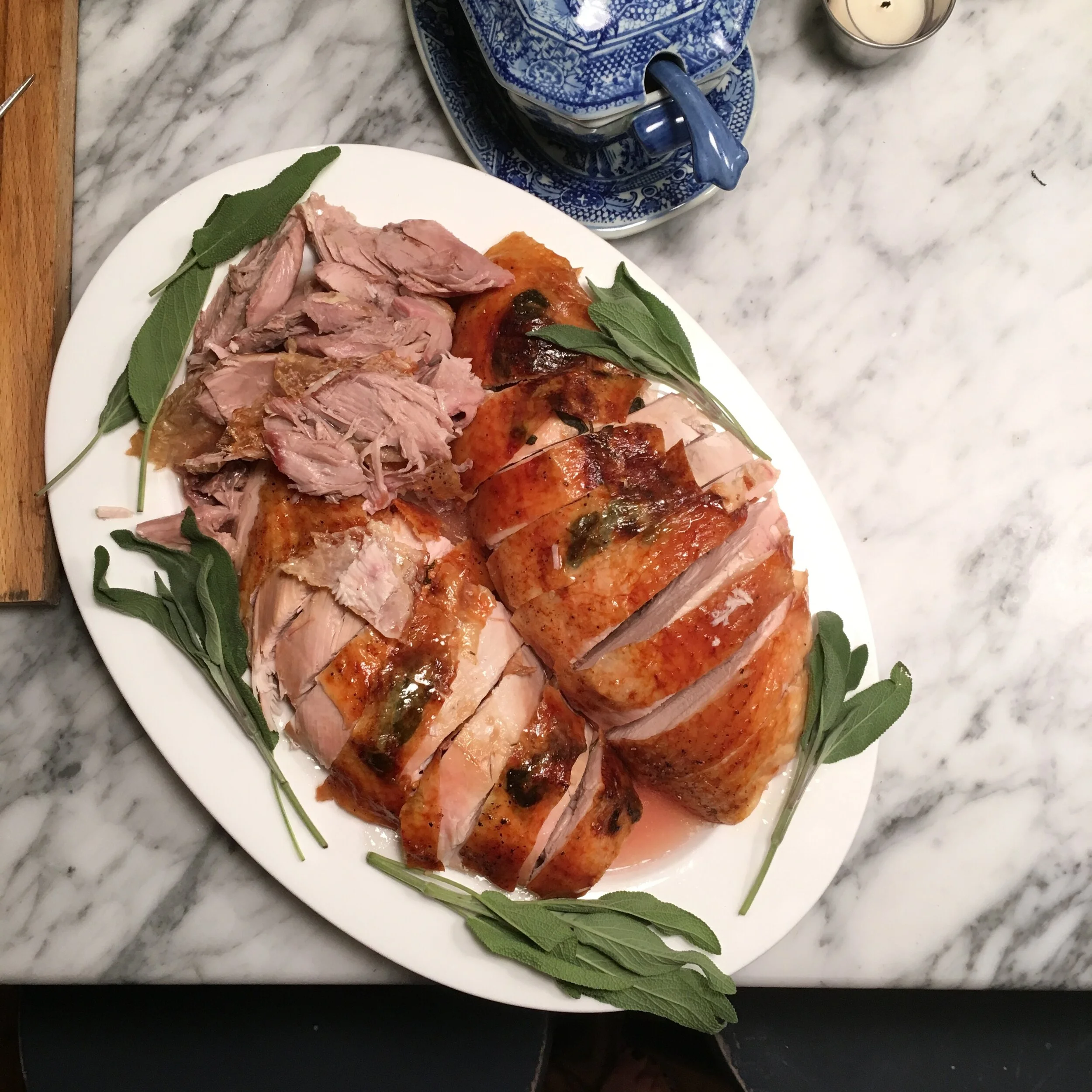Herb-Roasted, Dry-Brined Turkey—for Beginners
The biggest worry when roasting a turkey on Thanksgiving? Drying it out. Try roasting a petite10–12-pound bird, ensuring you’ll cook the legs and thighs all the way through while maintaining tender, juicy breast meat. This should serve 6 adults easily; should you have a larger group, roast two! Or try a rolled turkey breast in addition to a whole bird. (For a list of local farms, butchers, grocers and other sources for getting your hands on a locally-raised turkey, click here.)
The best way to achieve a moist, delicious bird that’s perfectly seasoned is to dry brine it. Wet brines involve buckets and water and can make a big mess, and to my palate the result is more like ham than poultry. But by rubbing a turkey all over with a blend of coarse salt, herbs, citrus zest and spices and letting it rest, uncovered, in your fridge for 36–48 hours before you roast it, you’ll infuse the meat with flavor and ensure a crispy skin, juicy breast and delectable dark meat.
TURKEY AND BROTH
1 10–12-pound turkey, local if possible and defrosted
4 carrots, peeled
4 onions, peeled
6 ribs celery, cut into 1-inch lengths
4 cloves garlic
1 bay leaf
1 stick unsalted butter
DRY BRINE
½ cup coarse sea salt
1 cup fresh sage leaves, packed, plus more for stuffing and garnish
2 tablespoons fresh thyme leaves, plus more for stuffing and garnish
2 tablespoons fresh rosemary leaves, minced
zest of 1 lemon
2 tablespoons turbinado sugar
freshly ground black pepper, to taste
GRAVY
½ cup white wine or apple cider
½ cup all-purpose flour
½ cup red wine
reserved broth
Two days before Thanksgiving, remove the neck and giblets bag from the cavity and set aside. Save the liver for another use. (Note: Sometimes the giblets are hidden in the neck pouch, so be sure to look there!)
Rub the bird all over with your dry brine mixture, about 1 tablespoon per pound, and set it on a rack in a roasting tin inside the fridge, uncovered, for at least one day but up to three.
Take the neck, heart and gizzard from the giblets bag and place in a saucepan with half an onion, a carrot, some chopped celery, a few cloves of garlic and some fresh herbs. Bring to a simmer, reduce the heat to low and continue to cook for about an hour. Strain and reserve this broth for your gravy.
On Thanksgiving morning, preheat the oven to 400°F and remove the turkey from the fridge and let it come to room temperature on the counter; take this time to work on your side dishes. Pour away any liquid that has accumulated in the bottom of the roasting pan; it will make your gravy too salty.
Using your hands, separate the skin from the breast meat and insert 2 tablespoons of room temperature unsalted butter under each side and spread, pressing through the skin from the outside. Rub the outside of the turkey with another 3–4 tablespoons butter, some cracked black pepper and another little sprinkle of salt.
Stuff half an onion, a chopped carrot and a few pieces of celery into the cavity, along with a big bunch of fresh thyme and sage and the bay leaf. Scatter the remaining carrot, onion and celery in the pan around the turkey. Pour half a cup of white wine or apple cider and half a cup of water into the bottom of the roasting tray. Tie the legs together at the knuckle and place the turkey in the oven to roast for 45 minutes, undisturbed.
After 45 minutes, remove the turkey from the oven and spoon some of the juices from the bottom of the roasting pan over the breast. Return to the oven, reduce the temperature to 375° and roast for another 2½ to 3 hours (around 15 minutes per pound) or until the thigh registers 160° on an instant-read thermometer. Rotate the bird every hour or so while it cooks to ensure even browning, and baste as you wish.
Remove the turkey from the oven, transfer to a carving board and cover the breast with foil, then layer on a heavy towel or two to keep in the heat. Remove the roasted vegetables from the roasting pan and set aside. Place the roasting pan on a stove burner, ready to make the gravy. Allow turkey to rest AT LEAST 30 MINUTES before carving, up to 90 minutes if you need more time preparing the rest of the meal.
While the turkey rests, make the gravy. Add the reserved vegetables to the broth in a saucepan and bring to a simmer. Heat the remaining fat and juices in the roasting pan (directly on a stove burner) until sizzling, then sprinkle in the flour. Using a wooden spoon, “fry” the flour in the fat until lightly browned, then add the red wine. Cook off the alcohol, then add hot broth, spoonful by spoonful and whisking until you have a thickened gravy. Taste for seasoning and add more salt or pepper, even a splash of apple cider vinegar to balance the flavors.
Carve and serve: If this is your first time roasting and serving a turkey, take it from us—there really is only one way to carve it. It’s important to take the breasts off first, then slice them crosswise. Here are the essential instructions from the ultimate in entertaining herself, Martha Stewart.
Arrange the sliced turkey on your biggest platter and garnish with more sage or thyme. Serve with gravy, Cranberry-Orange Relish and all the fixins.




